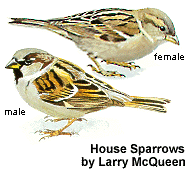
House Sparrow
(Passer
domesticus)
Cool fact: One hundred House Sparrows were introduced into Brooklyn in the fall of 1851 and the spring of 1852. From this initial introduction, the species expanded throughout the eastern United States and Canada. Aided by transplants from established populations and additional introductions from Europe (for example, into San Francisco and Salt Lake City in 1873-1874), the species now ranges from central and northeastern British Columbia to the James Bay and south to Panama.

The House Sparrow is one of the few introduced species that has succeeded greatly. The species is native to and resides from Britain, northern Scandinavia, and northern Siberia to northern Africa, Arabia, India, and Burma. House Sparrows have been introduced into South America, southern Africa, Australia, and New Zealand, in addition to North America. A nonmigratory species, House Sparrows are closely tied to human activity. This sparrow is usually absent from extensive woodlands and forests and from grasslands and deserts. In the far northern parts of its range and in arid regions, House Sparrows are typically present only in the vicinity of human habitation. In agricultural areas, an average of 60 percent of its food comes from livestock feed, 36 percent from weed seeds, and 4 percent from insects. In urban areas, bird feeders provide more food for House Sparrows. The initial successful introductions in the late 1800s were made in urban areas, where House Sparrows adapted to using the feed and waste products of the horses that provided transportation at that time.
The number of House Sparrows in continental North America is estimated at approximately 150,000,000 birds, but Breeding Bird Survey data indicates that the population is declining, particularly in the Maritime provinces and in the eastern and central United States. Changes in agricultural practices, in particular the shift to monoculture crop plantings, have been suggested as the cause. .
The song of the House Sparrow consists of cheep or chirrup notes repeated over and over. The birds sing year-round, although less frequently in August and on cold and rainy days. Both sexes cheep, the females most frequently when they are without a mate. Most vocalizations are associated with the nest site. Although House Sparrows are quite gregarious and nest in loose knit colonies, they defend a small territory immediately surrounding the nest. Males defend these territories from other males, and females from other females. Holes are preferred as nest sites, but nooks and crannies in outbuildings and open sites in trees and shrubbery are also used. The young form flocks soon after fledging, and most disperse from the natal colony. Large post-breeding flocks roost in trees or brush near grain fields in agricultural areas or in cities, from which they fly to feeding areas. After arriving at the congregation site, the birds often engage in communal singing for up to an hour.
Description: Although House Sparrows belong to a different family of birds, they closely resemble North American sparrows. They are short and stocky with shorter legs and thicker bills than native sparrows. The back is brown with black streaking. The breast and belly are unstreaked dull gray. Males in breeding plumage have a gray crown, with chestnut bordering the crown and extending down the back of the neck. The cheek and side of the neck is white. A black bib extends to the throat and meets the black stripe in front of the eye. The bill is dark gray black, and the legs are pale brown. The rump is gray, the shoulders are chestnut, and the wings are brownish with a white wing bar. The tail is dusky gray brown. Fall and winter males may lack the bright colors and black bib.
Females have a grayish brown crown and a grayish buff superciliary stripe. They lack the chestnut and black colors of the male, and their upperparts and wings are much grayer than the male. The back is light brown with black streaks; the rest of the head, breast, and sides are grayish brown. The belly is dull white. The bill and legs are pale brown. Immature males resemble females, except for the darker crown and a faint grayish bib.